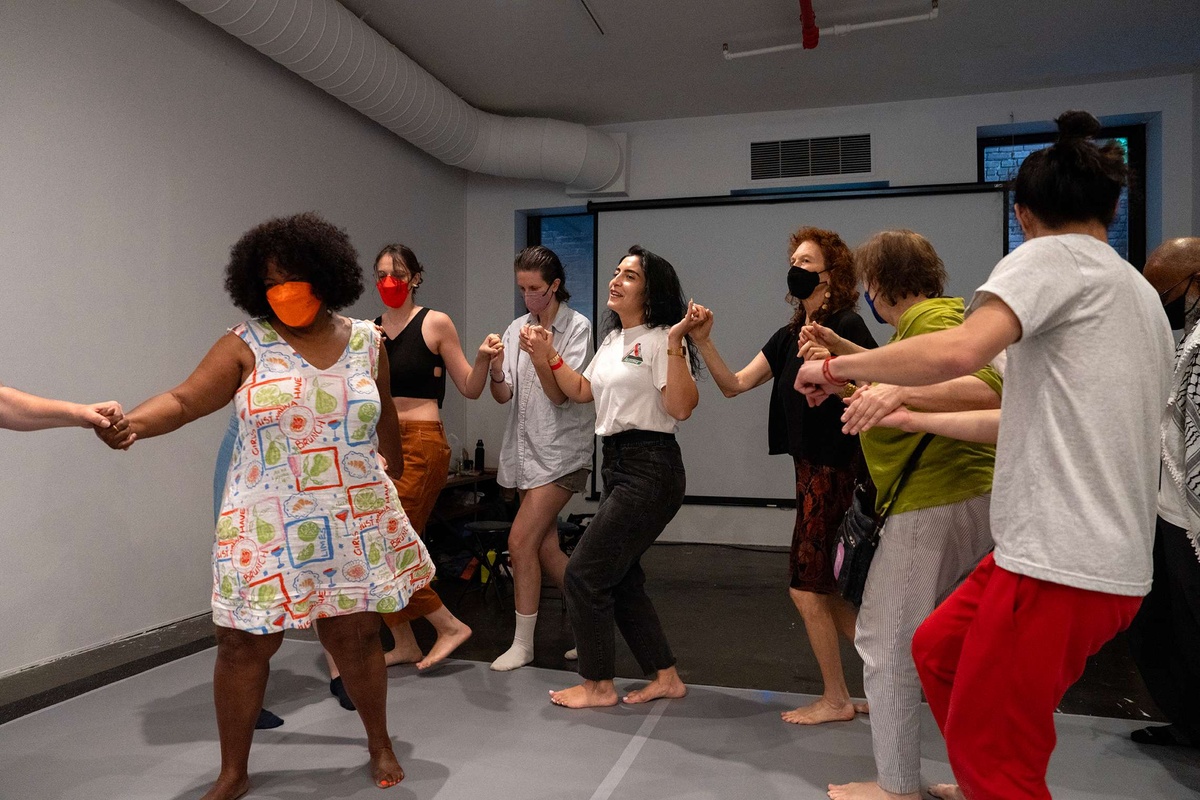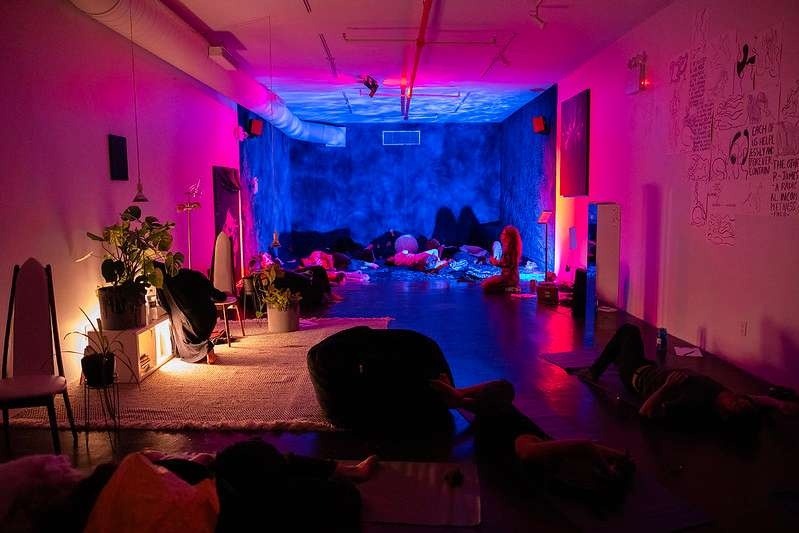Speaking Nearby Tiffany Jayeon Shin’s Microbial Speculation of Our Gut Feelings
Ana Iwataki
Tiffany Jaeyon Shin’s Microbial Speculation of Our Gut Feelings is a call to collaborators—human, plant, bacterial, and the in-between—to take part in a collective practice of care. In the middle of winter, in Brooklyn, living things are sprouting at Recess, where a pre-fabricated grow-tent houses micro greens, arugula, and other edible plants that will eventually be foraged for consumption. The day I visited, it snowed. Inside, Shin was wearing a t-shirt. The space smelled like some of the ingredients of life: dirt, fermentation, humidity. Lactic acid bacteria (LAB), which Shin cultivated in the space using an open-source method developed by a Korean organic farming group JADAM, fertilized the soil for the seeds, and continues to be used in their cultivation. Five collaborators, some individual, some collectives, are invited into the space throughout the duration of her residency to offer their own practices of fugitive survival, from fermentation as harm reduction to expansions of our relationships with food and waste. Collaboration and togetherness unfolds in ways both tangible and invisible, in ways we recognize and ways we must learn to see.
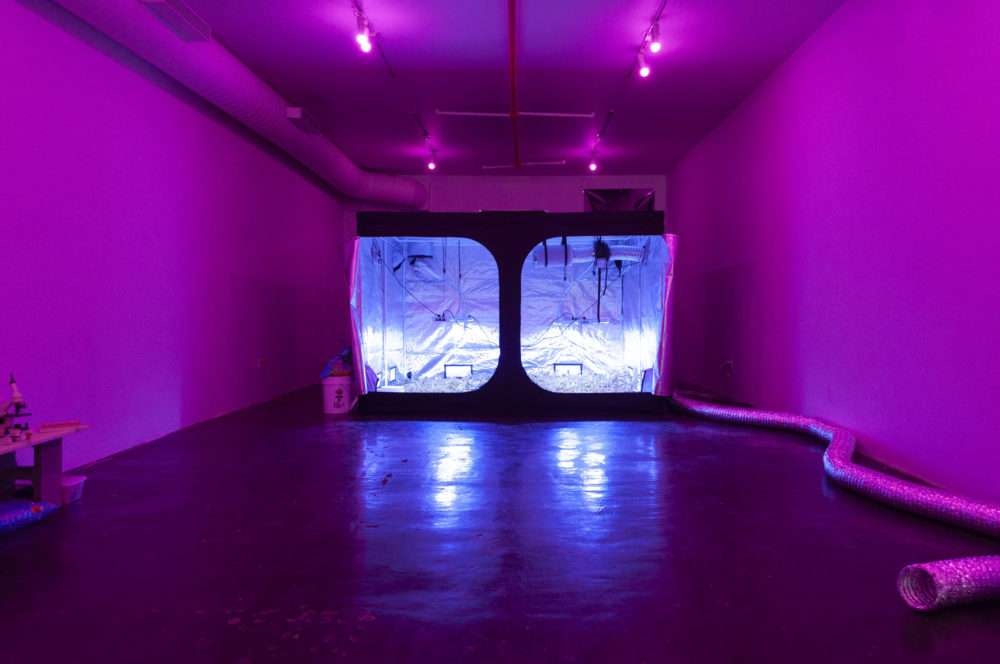

Tiffany Jaeyeon Shin’s Grow Tent
Shin visits the plants in the space every day to assist in their cultivation. She offers them care; they offer her a vibrant connection to place. This quotidian relationship to plants, bacteria, and place is underscored by the simple materials that make the project possible. Everything in the space, from the grow-tent, to the lights nurturing the plants, to the beakers in which the LAB is fermented is pre-fabricated, and as widely and cheaply available. It is a project of intention and care as praxis. Also at stake is the desire to mitigate the damage of the commodification of care—the wellness industry’s capitalist usurpation of practices that have long-existed and been widely shared. Shin invites us to consume with intention and in community, rather than mindlessly and with violence.
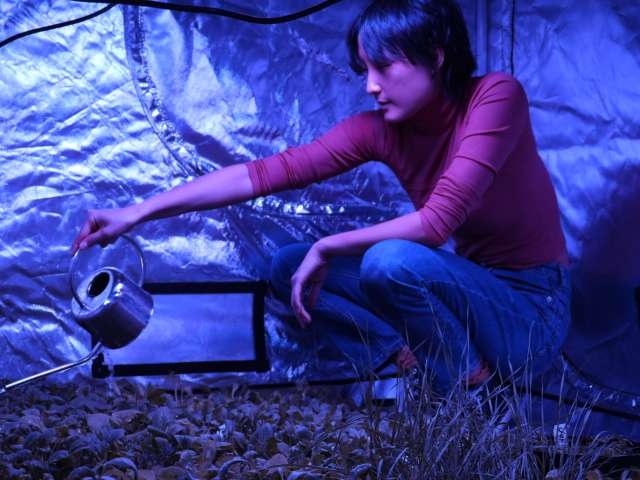

Tiffany watering the plants | Day 22
Shin’s project recalls gimjang, a Korean winter ritual during which families and neighbors come together to make large amounts of kimchi that will be stored, traditionally in earthenware buried in the ground, to be eaten all year round. The collective nature of this ritual is in fact two-fold—it brings humans together with the cabbages grown on their lands, and with the microbes that play an essential role in the fermentation process. LAB is a major by-product of the fermentation process that creates kimchi. Present in smaller amounts among many other kinds of bacteria in the raw ingredients of kimchi, its numbers dramatically increase as the fermenting process unfolds. In light of this, the gimjang brings together human communities and is a call to these unseen bacterial collaborators. To delve even further below the surface of this trans-species relationship, the human microbiome is now understood to be composed by significant numbers of non-human cells, which include bacteria, viruses, fungi, and other single-celled organisms. LAB is naturally occurring in the human gastric, urinary, and genital systems. A recent study shows that the number of human to non-human cells that make up the body is nearly equal, encouraging a shift of the paradigm of what it means to be a self. [1] When the human body dies, these other members of the microbiome live on. [2] Without erasing the particularities of the lived experience of bodies, especially marginalized ones, this explosion of the very idea of a “self” does much to trouble notions of individualism, biological essentialism, as well as decay and death.


Blown up image of kombucha under a microscope
In this vein, feminist theorist Stacy Alaimo offers the concept of “trans-corporeality,” an embodied ontology asserting that “…all creatures, as embodied beings, are intermeshed with the dynamic, material world, which crosses through them, transforms them, and is transformed by them.” [3] This theory seeks to dissolve the predominantly Western conception of the world in which the human reigns as the “figure” on and over the “background” of the environment. Dr. Robin Wall Kimmerer is an environmental biologist and member of the Citizen Powatomi Nation whose research focuses on ecological restoration and the restoration of relationships to land. In her writings on “becoming indigenous to place,” [4] she holds that while history cannot be changed, immigrants can come into a relationship of deep reciprocity to land. In describing the Powatomi language, she speaks of a “grammar of animacy,” [5] in which the structure of the language itself reveals and enacts a worldview that holds the entirety of the living world on the same plane as humanity. “A bay is a noun only if water is dead. When bay is a noun, it is defined by humans, trapped between its shores and contained by the word. But the verb wiikwegamaa—to be a bay—releases the water from bondage and lets it live.”[6]
Shin mobilizes trans-corporeality and a grammar of animacy material through her attention to the human-microbe relationship. Microbial Speculation of Our Gut Feelings is in part a response to a 2018 study that examines the loss of diversity in the microbiome that immigrants quickly experience on arrival to the United States. LAB has incredible restorative properties, and can rectify imbalances in the human gastrointestinal system as well as the rhizosphere, or the region of the soil influenced by root secretions. Shin is cultivating and harvesting vegetables in response to immigrants losing the microbe Prevotella, which is partly responsible for digesting fibers and vegetables. It is a restorative gesture against the narrative that the trajectory for immigrants is inevitably one of total assimilation into Western culture. Taking digestion as a framework to consider assimilation on cultural, microbial, and molecular levels—in a true deepening of the phenomenon—allows us to examine the immigrant’s effect on the lands they live, and vice versa. Reciprocity is inherent in this relationship, but it us up to us whether it is harmful—or not—to the receiving parties. Digestion offers a way of considering, at micro and macro levels, the administrative, physical, and affective violence inherent in settled lands to those who arrived there via multiple channels of migration.
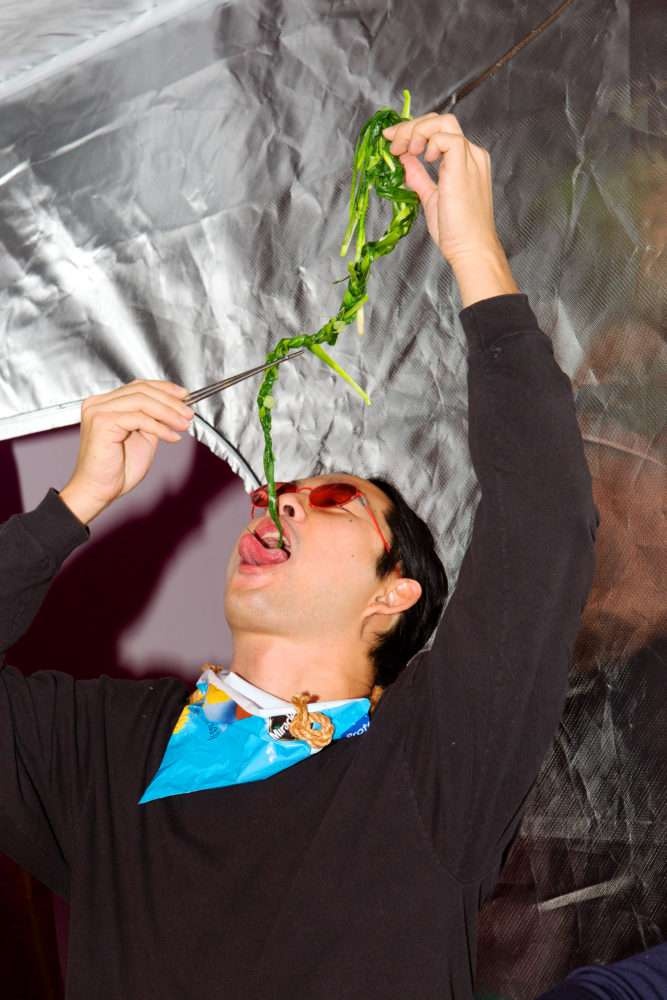

Guest eating during the Closing Reception Dinner with Spiral Theory Test Kitchen | Photo by Mary Kang
As another restorative practice of individual and communal care, Shin makes a fermented rice wine called makgeoli to serve to visitors. During my visit, I sipped on this drink, a product of centuries of tradition, Shin’s time in the space, and of the microbes present. As I was nourished by Shin’s libations, so were the plants. Milky, funky, sweet, and lightly alcoholic, the drink anchored our conversation with a sensory experience conducive to a deeper kind of memory. In return, the makgeoli was flavored by our overlapping preoccupations with ingestion and metabolism, as well as my own experience of growing up adjacent to one of the largest Korean diasporic communities in the United States. Artist, filmmaker, and theorist Trinh Min-ha offers the notion of “speaking nearby,” not speaking on behalf of an Other but rather “in proximity (whether the other is physically present or absent), which requires that you deliberately suspend meaning, preventing it from merely closing.” [7] This is also a practice of intention—a deliberate positioning of oneself in light of existing power structures and with awareness of the slipperiness of borders and identities. Even in discussing my own history, I must speak nearby. As a fourth-generation Japanese-American, a second-generation Filipinx-American, my relationship to land cannot be dissociated from events that I did not experience, such as the trauma of Japanese-American internment, the specter of Japanese colonialism, Filipinx indigenous and colonial history, and immigration. At once inside and outside, these histories flow in, over, and through me, metabolizing back into the world, just as the makgeoli did. More broadly, Shin’s project offers space to speak nearby our “selves.” If we take care to recognize the Otherness always already present within our bodies, microbes, this can give way to methods of being together that account for complexities and nuances that make up our histories, our relationships to land, and to each other.


Fermented Lactic Acid made by Tiffany Jaeyeon Shin
The language I have at my disposal, the one I call my native but not mother tongue, does not yet comprise a grammar of animacy. There are clear lines between you, me, us, them, it. Though I allow Shin’s drink, work, and words to flow through me; “I” still write nearby her, as porous as we might allow our boundaries to be within the dynamics of making together. But if we can conceive of paradigmatic shifts on molecular and microbial levels, perhaps changes can be enacted in other pillars of our togetherness, like communication, and by both gentle and radical turns, transform our conceptions of the world and the ways we live in it.
Shin gives us a wintry coming together during which we can recognize then instrumentalize the warmth of our bodies, the multitude of Others we carry in them, our wisdoms, our practices, our care. Material is offered for consumption for us to affect and be affected by. This nudge towards entanglement, responsibility, and care is at once breathtakingly humble and necessarily ambitious. We are nearby, animate, always consuming, and always consumed.


Guests during the Closing Reception Dinner with Spiral Theory Test Kitchen | Photo by Mary Kang
Footnotes
-
Sender, Ron et al. “Revised Estimates for the Number of Human and Bacteria Cells in the Body.” PLoS biology vol. 14,8 e1002533. 19 Aug. 2016, doi:10.1371/journal.pbio.1002533
-
Metcalf, J. L., et al. “Microbial Community Assembly and Metabolic Function during Mammalian Corpse Decomposition.” Science, vol. 351, no. 6269, 2015, pp. 158–162., doi:10.1126/science.aad2646.
-
Alaimo, Stacy. “Trans-Coporeality.” Posthuman Glossary, by Rosi Braidotti and Maria Hlavajova, Bloomsbury Academic, 2019.
-
Kimmerer, Robin Wall. Braiding Sweetgrass: Indigenous Wisdom, Scientific Knowledge and the Teachings of Plants. Penguin Books, 2020.pp. 205-215.
-
Ibid. p.55.
-
Ibid.
-
Trinh, Thi Minh-ha. Elsewhere, within Here: Immigration, Refugeeism and the Boundary Event. Routledge, 2011.
About the artist
Ana Iwataki
Ana Iwataki is a curator, writer, and translator. She is the Associate Curator with the FLAX Foundation and Co-Editor of the X Topics book series published by X Artists’ Books. Previous positions include Associate Director, Commonwealth and Council, Los Angeles and Exhibitions and Publications Manager, the Chalet Society, Paris. She has curated exhibitions independently, in collaboration with Marion Vasseur Raluy, and as co-director of the independent exhibition space Shanaynay, Paris. Recent exhibitions were organized at Los Angeles Contemporary Exhibitions (LACE), Los Angeles; Balice Hertling, Paris; Visitor Welcome Center, Los Angeles, LAMOA DS#3 at Commonwealth and Council, Los Angeles; 67 Steps, Los Angeles; Bel Air, Essen, Germany; and le Doc, Paris, France. An anthology based on a year-long Art Viewer Screen program organized with Vasseur Raluy was published by Hololoholo Books in April 2018. She has recently contributed essays to the Recess Critical Writing program, X-TRA Contemporary Art Quarterly, the Baltic Triennial 13 catalogue, the Los Angeles Review of Books Quarterly Journal, among others. As a consultant, she is working with the ACLU SoCal in building their inaugural Artist-in-Residence program. She received her BA in Art History from Pitzer College, Claremont, CA and MA in Curating Contemporary Art from the Sorbonne, Paris, France.
Explore/Archive
See allJanuary 2026
Freedom Time Meditation: Cartographies of Release
Neta Bomani
Artist and educator Neta Bomani offers a guided meditation on FREEDOM TIME: Undanced Dances Through Prison Walls
December 2025
The INSTITUTE FOR TRANSHUMANIST CEPHALOPOD EVOLUTION and Learning from Octopuses
Barbara London
Barbara London reflect's of Miriam SImun's INSTITUTE FOR TRANSHUMANIST CEPHALOPOD EVOLUTION
October 2025
streamlined reflections, courtesy of noise canceling headphones
Gabrielle Rucker
Gabrielle Rucker reflects on the radical intimacy and auditory life at the heart of Deli Radio
